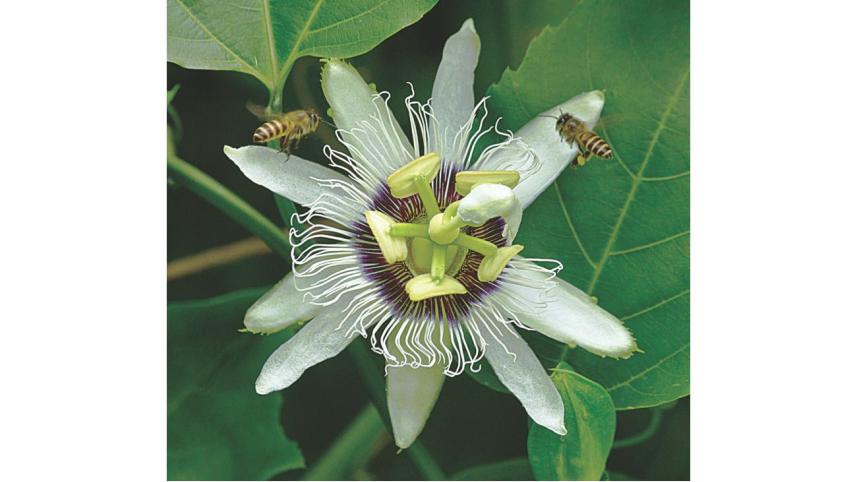Blossom

It is spring and blossoms are blooming for many of our summer fruits. While the mango blossom has been immortalized in our national anthem, there are many others around us.
One of my favourite blossoms is that of the rose apple (golapjam). Hundreds of white stamens radiate outwards from its centre like an explosion. The beauty of this blossom makes up for the bland taste of the fruit.
Pretty blossoms come from unexpected fruits. Passionfruit, also known as tang fruit, is an easily grown, prolific creeper that does well in shady balconies. Its blossom has an intricate beauty. The fruit itself is flavourful and delightfully sour. You can find seedlings at the annual brikkho mela.
The red sour fruit called chukka or hoilfa has an elegant blossom: deep scarlet inside, delicate beige outside. They remind me of okra (dharosh) blossoms which are a pretty shade of yellow with purple at centre.
Cherry blossom is perhaps the most famous blossom in the world. Its delicate pink shade is seductive. In Japan – and other places – appearance of this blossom is cause for celebration since it signals the end of winter and the beginning of spring. Most of the ornamental cherry blossom trees (there are around 200 species in Japan) do not produce cherry fruit which is the product of a related tree.
The blossom of the jackfruit tree, however, is not a flower. Rather, it is a cylindrical object, called a muji, which is covered in a shiny green skin. In a few weeks, skin detaches revealing the tiny jackfruit. In two short months, the tiny muji becomes a massive fruit weighing several kilograms.
Many blossoms are edible, my favourite being tok aamra blossom. Its delicate fragrance, sharp taste and grainy texture are best enjoyed in a sour tok (or khatta in Sylheti cuisine.) Aamra blossoms also lend themselves well to achars. Pumpkin blossoms are delicious sautéed or in an omelette. The banana blossom is boiled, mashed and fried into patties. The artichoke is actually the blossom of a certain variety of thistle, eaten before it blooms. It was a favourite of ancient Romans. The beauty of artichoke is that once you have a "colony" growing, plants automatically rejuvenate and expand every year.
Several members of the citrus family have distinctive looking blossoms. For example, the pink-white blossoms of some lemons cluster tightly into a ball before separating into individual flowers. Orange blossoms are, of course, famous for the honey they yield.
The betel nut's blossoms appear as triangular bunches of bright yellow strings that shimmer, high up, against the green leaves and trunks. But I am not so fond of some other nut blossoms, such as cashew, which are stringy and anemic. Another irritating blossom is that of kalojaam: not substantial, and inconveniently appearing in the most unreachable, highest branches of this large tree.
If you have orchards, blossoms give an indication of the size of the coming harvest. In some commercial orchards – such as mango – blossoms are often sprayed with pesticide to prevent bugs inside the fruit.
Blossoms are short-lived and attract insects with their high nectar content. Nevertheless, as a photographer I enjoy working with them because they often yield good pictures.
www.facebook.com/tangents.ikabir



 For all latest news, follow The Daily Star's Google News channel.
For all latest news, follow The Daily Star's Google News channel.
Comments